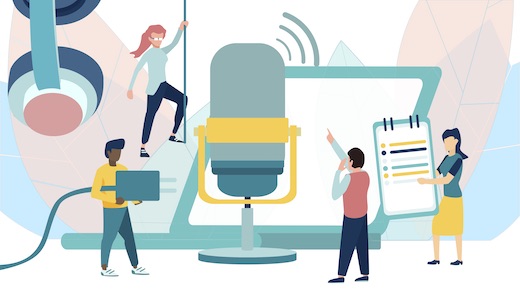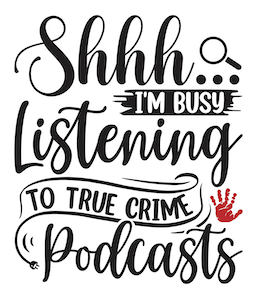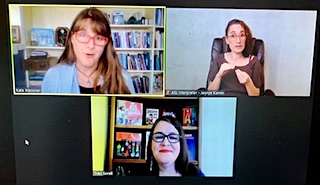Use Podcasting to Teach Fluency, Explore Genre
By Jason D. DeHart

As is consistently the case throughout my media-related series of MiddleWeb posts this year, the core question is: What does this mean for the classroom?
Communication changes, as teachers and students know, and this second post in the series focuses on the ways that podcasts can be used with middle schoolers.
As the ways that students read and encounter information changes, greater possibilities exist for what can be practiced in the classroom. This sense of change is also evident in the ways that connections occur between and among people.
It All Comes Back to Text (Always)
A variety of texts should be part of classroom practice, including prose, poetry, comics, film, web spaces, and more. My goal throughout these posts is not to move one type of composing and sharing front and center, but to suggest that each type of text brings its unique power and connects with students in specific ways.
Podcasts offer possibilities for composing as well. There are some essential components of literacy that can be reached through the podcasting process.
Fluency
Scholar and educator Molly Ness has written about the possibilities of using podcasting as a way of helping students build fluency. The traditional and prescriptive approach to fluency is reading and rereading, often with a timer.
While this is an approach that has been around for a while, some students find the presence of the timer to be stressful, and the rereading process can be the result of compliance instead of engagement. The result is mechanistic and, though potentially useful, there are creative and invitational ways to help students engage in rereading without the stress of being on the clock.

► Engaging with a text (fiction or nonfiction) for reading and responding
► Scripting discussion of the text to establish key points based on the needs of an audience
► Practicing delivering the script for the recording
► Rough draft recording
► Editing/Revising
► Choosing the best ways to publish and share
In this six-step process, students are touching on multiple standards in the domains of writing, reading, and using digital tools – along with practicing the speaking and listening skills that are sometimes only addressed through class speeches.
Podcasting, envisioned as a kind of digital reader’s theater or running literacy commentary, can invite students to read and reread the source text they are using for an initial read, the source text again for scripting, their own script for delivery on at least two occasions, and then the recorded product as a final process for editing.
Genre-Linked Creation
There is notable possibility in the act of creation itself as students think back on and envision texts after reading. From true crime to sports commentary, podcasts hold a number of possibilities for serving as an interactive and multimodal text for a variety of genre and topic-based responses.

In this day and age, the multi-genre unit that has been around for decades can take on new life and possibilities. This type of work is often best done collaboratively, although I am thinking of students who prefer to work on their own and may even have experienced creating in these forms as part of their home literacy lives.
Podcasts are just one example of thinking about ways to connect and enrich home and school literacies, helping students bridge what they love to their daily work. They can move into the commentator seat, remarking on popular culture and interests in ways that build and sustain engagement with digital tools and writing/creating processes.
In collaborative teams, students can work to divide tasks, engage in text-creation, and form groups and subgroups based on the topics they find interesting. Possibilities exist for using student-friendly podcasts as mentor texts, and editing can go from simple (adding music to the beginning and end of recordings) to complex (adding sound effects, splicing audio, removing extraneous speech).
Connection
Now let’s consider the possibilities for using podcasts as an authentic means of engaging with both an audience and author communities. The interview format of podcasts has inspired my own work in advancing literacy, and student/student groups can brainstorm ways to invite author voices or use podcasting as a way of supporting and extending author visits.

What’s more, within the boundaries of what is comfortable for families, podcasting can be a venue for sharing voice and thoughts in open online spaces, with teacher direction and support. Consider the possibilities for practicing and enacting digital identity and maintaining responsible interactions with a global audience in mind.
While the steps to engaging in this public way might require family support and include considerations of school district policies, generating a conversation designed for public sharing takes on more immediate relevance for students when access to a wide audience is a constant reality.
Dr. Jason D. DeHart teaches English at Wilkes Central High School in Wilkesboro, North Carolina. He taught English Language Arts to middle grades students in Cleveland, Tennessee for eight years, earned his doctorate, and served as an assistant professor of reading education at Appalachian State University before returning to his first love, the secondary classroom.
Jason’s work has appeared in Edutopia, SIGNAL Journal, English Journal, The Social Studies, and the NCTE Blog. See all of Jason’s MiddleWeb posts here – including a 3-part series with teacher and school librarian Jennifer Sniadecki on using picture books with middle level readers. His website Book Love: Dr. J. Reads offers book reviews and author interviews.






























